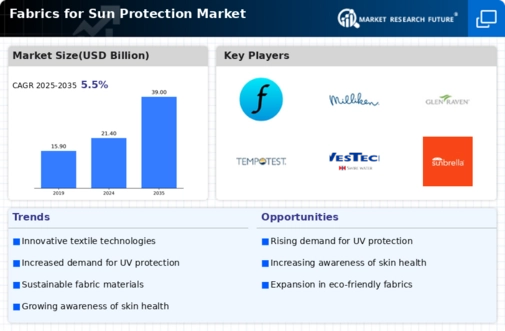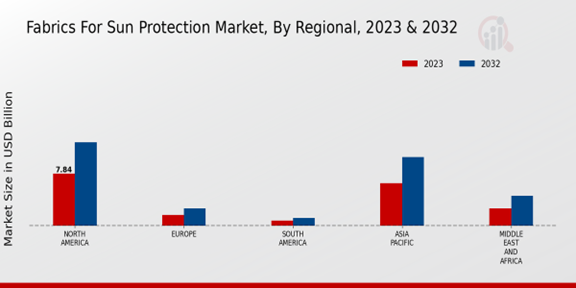Market Growth Projections
The Global Fabrics for Sun Protection Market Industry is poised for substantial growth, with projections indicating a market value of 21.4 USD Billion in 2024 and an anticipated increase to 39.0 USD Billion by 2035. This growth trajectory suggests a robust demand for sun-protective fabrics, driven by various factors such as increased awareness of UV risks and technological advancements in fabric production. The compound annual growth rate (CAGR) of 5.59% from 2025 to 2035 further emphasizes the market's potential for expansion. As consumers continue to prioritize sun safety, the industry is likely to evolve, presenting new opportunities for manufacturers and retailers.
Increasing Awareness of UV Protection
The growing awareness regarding the harmful effects of ultraviolet (UV) radiation on skin health is a primary driver of the Global Fabrics for Sun Protection Market Industry. As consumers become more educated about skin cancer and other UV-related health issues, the demand for protective fabrics is likely to rise. This trend is evident in various sectors, including outdoor apparel and sportswear, where brands are increasingly incorporating UV-blocking technologies. The market is projected to reach 21.4 USD Billion in 2024, reflecting a significant shift in consumer preferences towards sun-safe clothing options.
Diverse Applications Across Industries
The versatility of sun-protective fabrics across various industries contributes to the expansion of the Global Fabrics for Sun Protection Market Industry. Beyond apparel, these fabrics find applications in sectors such as automotive, home furnishings, and outdoor gear. For instance, the use of UV-resistant materials in car interiors and outdoor furniture is becoming increasingly common. This diversification of applications not only broadens the market's reach but also attracts a wider range of consumers. As industries continue to recognize the importance of UV protection, the demand for specialized fabrics is expected to grow, further solidifying the market's position.
Regulatory Support for Sun Safety Standards
Regulatory bodies are increasingly implementing standards and guidelines to promote sun safety, which serves as a significant driver for the Global Fabrics for Sun Protection Market Industry. Initiatives aimed at educating the public about UV exposure and encouraging the use of protective clothing are gaining traction. For example, some countries have established regulations that require labeling for UV protection levels in textiles. This regulatory support not only enhances consumer confidence but also incentivizes manufacturers to invest in sun-protective technologies. As a result, the market is likely to see sustained growth as compliance with these standards becomes more prevalent.
Technological Advancements in Fabric Production
Technological innovations in fabric production are transforming the Global Fabrics for Sun Protection Market Industry. Advances in textile engineering, such as the development of synthetic fibers with enhanced UV protection properties, are enabling manufacturers to create more effective sun-protective fabrics. For instance, the integration of nanotechnology in fabric treatment has shown promising results in improving UV resistance. This evolution not only enhances product performance but also attracts consumers seeking high-quality sun protection solutions. As a result, the market is expected to experience a compound annual growth rate (CAGR) of 5.59% from 2025 to 2035.
Rising Outdoor Activities and Sports Participation
The increasing participation in outdoor activities and sports is driving the demand for sun-protective fabrics within the Global Fabrics for Sun Protection Market Industry. As more individuals engage in activities such as hiking, cycling, and beach sports, the need for protective clothing becomes paramount. This trend is particularly pronounced among younger demographics who prioritize both performance and safety in their apparel choices. Consequently, brands are responding by developing specialized clothing lines that offer UV protection, further fueling market growth. By 2035, the market is anticipated to reach 39.0 USD Billion, underscoring the potential for expansion in this sector.











